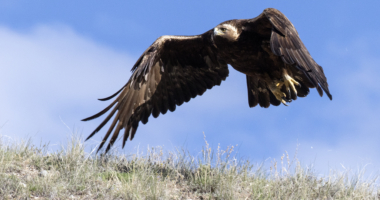A Tale of Two Eagles

by Amy Seaman
With a few early snow storms launching us into winter, another fall raptor migration season has passed. This season, like the preceding decade of seasons, raised a familiar question in many people’s minds, “how can you tell immature Golden and Bald Eagles apart, and what are those eagles with white bellies?” Well fortunately in Montana, winter is a great season to improve your understanding of eagle identification. Eagles can be tough to tell apart, but there are a few key field marks to keep in mind.
Bald Eagles have great big heads, and large broad wings held out from the body at an almost ninety degree angle. Similarly, the leading edge of the wing connects the head at a nearly ninety degree angle, and they almost always fly steady despite strong winds. In their first year Bald Eagles have a dark, rather than brilliant yellow beak, and they sport a variable amount of white mottling in both body and flight feathers. First-year birds have brown bellies and dark brown heads. As they age, the tail slowly turns from brown to white, as does the head, progressing through various distinct phases. One of the most distinct is called the “Osprey phase”, indicated by a residual brown stripe over the eye in an eagle with an otherwise white head. The white belly of the Bald Eagle is present in varying degrees in the birds 2nd and 3rd year of its progression to adulthood.
 Golden Eagles, on the other hand, generally have smaller heads, and like the name suggests, show a golden nape at all ages. Unlike Bald Eagles, young Golden Eagles show a varying degree of white coloration in their flight feathers (the tail, primary, and secondary feathers) and not in their body feathers (e.g underwing coverts). This is the key to telling young eagles apart – ‘balds’ have white in the body, and goldens have white in the flight feathers. A first year Golden Eagle is dark brown with crisp white patches in the tail and wings. As they age, those white feathers are replaced with brown, though some adult birds retain white in the tail at 5+ years. An adult Golden Eagle is all mottled brown, with a golden nape and mottled feathers along the shoulders. Be careful – a few missing body feathers on an adult Golden Eagle can look like a white body feather!
Golden Eagles, on the other hand, generally have smaller heads, and like the name suggests, show a golden nape at all ages. Unlike Bald Eagles, young Golden Eagles show a varying degree of white coloration in their flight feathers (the tail, primary, and secondary feathers) and not in their body feathers (e.g underwing coverts). This is the key to telling young eagles apart – ‘balds’ have white in the body, and goldens have white in the flight feathers. A first year Golden Eagle is dark brown with crisp white patches in the tail and wings. As they age, those white feathers are replaced with brown, though some adult birds retain white in the tail at 5+ years. An adult Golden Eagle is all mottled brown, with a golden nape and mottled feathers along the shoulders. Be careful – a few missing body feathers on an adult Golden Eagle can look like a white body feather!
Eagles are large, so when you have the chance to watch them, take it all in. Look at the wing and head shape, look at the distribution of white and brown feathers, look at the color of the beak, and look at the eagles from every angle possible.



